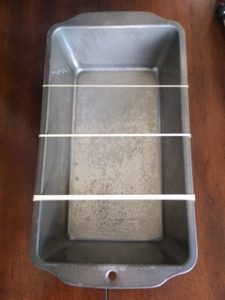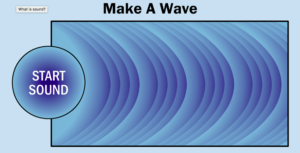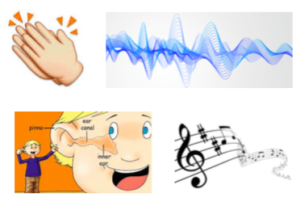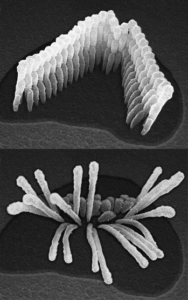Vibrations create waves in the air that travel to our ear which sends a message to our brain that we “hear” as music!
The waves are similar to what you see in a pool of water when you drop a pebble into the water.
Our third lesson helps children to understand what sound is and how it exists physically–waves and vibrations in the air that act upon our physical body–even when they can’t see those waves or vibrations with their eyes.
Lesson 3: Vibrations and Waves
Suggested tasting songs for this lesson:
Evelyn Glennie is a deaf percussionist who shows that you if you listen carefully by feeling the vibrations, you can learn how to make beautiful music. She plays barefoot sometimes because it helps her feel the vibrations better. She can even play with other instruments–even a whole symphony–because she is so good at listening! She plays on the drums and the marimba in this video. (Start at 7:10 for just the marimba performance.)
This is just a fun song to listen to for a minute and clap to, feel the beat.
Suggested teaching songs for this lesson:
You can review the school song or teach this song that relates to the lesson:
“Who Has Seen the Wind?” (Sing with Me, G-2-3)
This song puts music to the poem by Christina Rosetti:
Who has seen the wind?
Neither I nor you:
But when the leaves hang trembling,
The wind is passing through.
Who has seen the wind?
Neither you nor I:
But when the trees bow down their head,
The wind is passing by.
Lesson 3 adaptations for this lesson:
Learn more about sound from Dangerous Decibels.org
Classroom Resource Box materials available for you to use:
You will need to bring your own stock pot to tape the plastic wrap onto (be certain it is stretched taut across the top of the pot). (Scotch tape should be in the classroom. Arrive a few minutes early to do this if you don’t prepare it at home.) You also will need to bring a cookie sheet and a wooden spoon.
 (Be sure to take the rubber bands off the bread pan so that it will preserve its elasticity longer.😊)
(Be sure to take the rubber bands off the bread pan so that it will preserve its elasticity longer.😊)
This visual shows “Before and After Loud Sounds” – The top electron microscope photo shows the tiny hair bundle on top of a healthy inner ear hair cell. Compare it to the bottom electron microscope photo of a sound-damaged hair bundle again on top of an inner ear hair cell. Image and caption from http://www.dangerousdecibels.org/about-us/the-issues/.
Simplified explanation: If you listen to music too loudly in your headphones, you can permanently damage your inner ear cells so that you will lose hearing. Sound waves can be powerful! They are actually moving our bodies in ways we can’t see with our eyes, but are real!
Other ideas for this lesson:
 Show how a wave works using this cool wave online demo resource.
Show how a wave works using this cool wave online demo resource.
This very cool video was made by a man who played sounds from a speaker (on the left) and stretched some rubber over a PVC pipe, and put rubber bands around it. He took a video of the sounds, and then he slowed the video way down so that you can see the actual vibration of the rubber to the sound coming out of the speaker!
Using salt on top of a special vibration plate, this man shows how different frequencies (speed) and amplitudes (volume/height of waves) of vibrations (think of notes going up a scale) create different salt (Chladni) patterns on the plate. Cool stuff! You can see that vibrations and waves (the pitch and volume of sound/music) affect physical matter!


